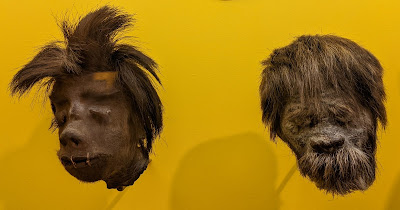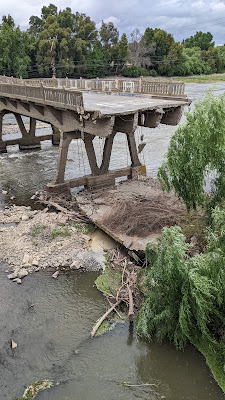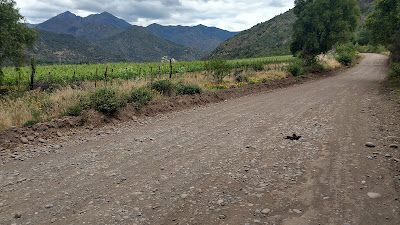I ended my first blogpost from Chile with hopes that the weather would cooperate, but that didn't quite exactly happen. For several days I would see only an occasional patch of blue sky, quickly obscured by grey clouds. In my daily Facebook posts and also in my Strava feed I'd often lament that the day could have been spectacular if the greyness had lifted and I'd had a full view of the snow-covered cordillera that never was much more than 40 or 50 miles away. If there was something that could have been better about this trip, well, that was it: the weather.
This string of gloomy weather days had started on the morning of my departure from Santa Cruz, and since my check-in time in Talca was still hours away I decided to visit the local museum. Well, let me tell you, the Museo Santa Cruz is one of the most enjoyable museums I have ever visited. It all was covered: the Pleistocene, the conquest, the revolution, the 19th century, the mining accident and the miracle of the 33 rescued miners 12 years ago. (The pics above decided to reverse this timeline.) If you find yourself in Santa Cruz, do yourself a favor and spend the $4 (OK, that's after the senior discount) on a ticket to this fabulous place.
Somehow it had never before registered for me that Chile is an agricultural powerhouse. Most of the produce that's being sold in our supermarkets in Texas comes from Mexico (unless it's from California), except for grapes from Chile. But ride through these fertile valleys and you will see that fruit and vegetables are king down here, and my guess would be that much of it is being exported. The number and size of the orchards and fields are staggering, and even though wine production is obviously of great importance, the other agricultural products are hardly secondary. A bit of Googling revealed that Chile is one of the world's top five producers of cherries and cranberries, and for apples, plums, kiwi, and hazelnuts it's in the top ten. As far as wine production is concerned, Chile trails Argentina by just a smidgen and is ranked #6 in the world.
After three nights in Talca it was time to move on. I headed north, paralleling but almost never seeing the Andes until I made it to Rancagua, located on the edge of the Cachapoal wine region. My Airbnb was a large house that had a lovely courtyard with plants and flowers. My two rides took me on long loops north and south-east of town, and both times I lucked out in mapping the routes. Even though the terrain looked mostly flat, the valleys are somewhat tilted so that the elevation profile usually looked as if I were going to climb some large volcano (or leave a mountain top, dip through a long valley to only climb back up to my mountain perch). It must have been sheer luck that these long climbs were generally aided by tailwinds while the headwind sections were made more than bearable by the slight but steady loss in elevation. Pretty sweet.
On my second ride from my Airbnb in Rancagua I "climbed" into the Cachapoal River valley (right diagram), steadily climbing with a tailwind on a beautifully paved road along this wide river. The valley narrows significantly after the initial flood plains. Tanker trucks carrying sulfuric acid were almost the only vehicles out; I assume that the acid is being used in the mining operations in the area. (Copper is Chile's most important export item, way ahead of any agricultural products.) At the turnaround I crossed over to the other side of the river and then rode a gravel road back to town. The headwind was barely noticeable, and the elevation loss made riding the gravel relatively easy.
Rancagua was the first place where I found something resembling a craft beer "culture" (although there had been the microbrewery in Los Andes). I visited several taprooms, and my rides ended on hoppy notes! Like so many other things in Chile, the beer wasn't cheap either: At one of these taproom I paid $15 for a pint on the premises and two cans of beer to go. But it sure was nice to drink a real IPA!
Despite my hopes and tentative plans of visiting a winery or two every day while cycling in a wine region those intentions didn't go very far. Altogether I stopped by three wineries, and the first one was what I had hoped to visit much more often: a small operation by the side of the road, with the vintner in a Calvin Klein t-shirt handing out samples from non-descript bottles. (The burdeo that I picked up received a proper label before the man gave me the botella.) The large wineries that I occasionally did see mostly appeared locked up, and tasting rooms were not evident. I talked to a few people about this, and the pandemic appears to be the culprit for much of this. It is possible to make online reservations for some (expensive) tours and tastings, but almost all of those are offered through commercial operators only. Wine tourism the way we know it in California or Texas simply doesn't exist in the same way in Chile.
Rancagua was the first place where I found something resembling a craft beer "culture" (although there had been the microbrewery in Los Andes). I visited several taprooms, and my rides ended on hoppy notes! Like so many other things in Chile, the beer wasn't cheap either: At one of these taproom I paid $15 for a pint on the premises and two cans of beer to go. But it sure was nice to drink a real IPA!
On a completely different note, I should not forget to mention the insane amount of trash along Chile's roads. Sometimes it seemed as if the entire right of way was a sanitary landfill—and all that despite all those signs asking not to throw trash or even reminding folks of the fairly hefty fines (the one pictured was the equivalent of about $250) that can be doled out. It's a shame that such a beautiful country is so full of litter.
Of course, don't mistake for trash the stockpiles of plastic bottles at the countless animitas, small memorial shrines for people who generally died in a traffic accident in this particular spot. Animitas (referring to the Spanish word anima, the soul) are often called descansos in Spanish-speaking countries. I did a little bit of Googling and learned that bottles are filled with water and left by passers-by who honor the unofficial patron saint of truck drivers in this way. Most animitas feature a tiny hut or house and often show personal effects of the person killed, such as a bike helmet, a stuffed toy, or car parts. I could never figure out the circus-themed animita that I saw in Maipo Valley.
The day I left Rancagua was also the day when the sun started to come out again, and once I made it to my last Airbnb of the trip in Isla de Maipo all the bitching and moaning about clouds and grey skies was forgotten. The snow-capped mountains, the blue sky, the lush greenery of the vineyards—it all came back together. Suddenly the temperature once again was warm enough to not have to ride with the winter jersey and the vest. My domicile, which also incorporated a large, beautiful garden and numerous friendly, tail-wagging dogs, was clean and bright, and so my trip ended on a very high note.
My two rides in the Maipo Valley, the final wine region that I visited, were both fabulous. The first one was 43 miles long, the second 55. On both days I enjoyed some of the finest vistas of the entire trip. The Maipo Valley is just an hour from Santiago, and I encountered numerous recreational cyclists on my first ride, which took place on a Sunday. The area has many excellent bike lanes, separated from the roads by color (sometimes blue, sometimes red) and physical dividers. Where no dedicated bike lanes exist the roads will usually have a sufficient shoulder to allow enough room between cyclist and motorist. Most of the time I felt very safe cycling in Chile, except for oncoming passing cars that would barrel toward me in my lane.
My two rides in the Maipo Valley, the final wine region that I visited, were both fabulous. The first one was 43 miles long, the second 55. On both days I enjoyed some of the finest vistas of the entire trip. The Maipo Valley is just an hour from Santiago, and I encountered numerous recreational cyclists on my first ride, which took place on a Sunday. The area has many excellent bike lanes, separated from the roads by color (sometimes blue, sometimes red) and physical dividers. Where no dedicated bike lanes exist the roads will usually have a sufficient shoulder to allow enough room between cyclist and motorist. Most of the time I felt very safe cycling in Chile, except for oncoming passing cars that would barrel toward me in my lane.
For the majority of my time in Chile I was really not quite sure when I would return to the US. Esteban had told me that the UCI's Pump Track World Championships were going to take place on November 20th, and I would have liked to see some of the international commissaires who were going to fly in. My initial return date was November 15, but just in case I made a second reservation for November 22. The nice thing about booking flights with miles is that one can make changes or cancel flights without any penalties until literally minutes before departure. I had my rental car until November 15, but Esteban kept telling me that he would take care of transportation, housing, everything. Not that I had any real reason to doubt him, but when I could not coax any precise details out of him even as that date kept coming closer and closer I decided not to hang out in Santiago, a huge metropolis of almost 7 million with a fair amount of pollution and not much architectural beauty. I just didn't feel comfortable with the entire situation, and so I decided to stick with my original plan.
So, after finally indulging in a glass of the sickeningly sweet mote con huesillos (dried peaches cooked in sugar, water, and cinnamon and then mixed with freshly cooked barley) I left Isla de Maipo a little before noon on Tuesday, November 15, and drove the 60-or-so miles into the city, back to Esteban's dad's house, where I had left the bike case and my rolling duffle. Esteban expected me (you may remember that he had been at a race on the day of my arrival in Chile and we had only texted but not seen one another), and it was a cordial reunion. The two of us had worked two races together about a decade ago, and we had stayed in loose contact for all those years.
Since my flight back to the US did not leave until 10 p.m., I didn't feel too stressed out about disassembling and packing the bike and repacking my other luggage. Once everything was ready for travel and put in the trunk of my Peugeot, Esteban and I went out for a few hours to enjoy a beer and catch up with one another. I left for the airport with plenty of time to spare, returned my car, wheeled my luggage into the terminal, got checked in, and spent a couple of hours in the tiny Pacific Club Salones VIP lounge—long gone are the days when American had a cushy Admirals Club in Santiago or when Latam was still a member of OneWorld and we got to enjoy that fancy lounge! Still, no complaints as there was a nice selection of self-serve wines, pisco sour, and other goodies. The flight took off more or less on time, my Business Class seat was comfortable, and we didn't even run out of port wine! Lie flat seats are great for overnight flights like this, and I slept about five hours and arrived relatively fresh in DFW early in the morning. I had enough time for a shower and breakfast in the Flagship lounge, and a few hours later, before noon, I was back in Lubbock where it was cold and windy. Welcome back to the reality of fall and winter!
To recap things, I am really glad that I went on this trip, even if there were far too many question marks in the run-up to my departure for and arrival in Santiago and even during my stay. I think it is best that I arrange everything for myself instead of seeking help from a local friend who comes from a different culture. Having lived with myself for going on 67 years I know that I need a precise plan and well-established structure to be content and happy. Latino culture doesn't always work like that. The travel snafus on the way to Chile were not something avoidable, and thanks to Keith and Cindy things worked out well.
I haven't yet tallied up the overall cost of the trip, but the rental car (thanks to the forced insurance that I had to take out at the counter, contrary to what I had researched and been told beforehand) was a pretty big line item at about a grand for the 17 days that I used it. (On the positive side, the diesel Peugeot 303 barely sipped fuel and I ended up with a gas mileage of an almost impossible 79 mpg!!!! My total fuel cost for driving 550 miles was a tad less than $40 even with a diesel price of almost $5 a gallon, which is still 70 cents cheaper than gasoline in Chile.) The Airbnbs had a nominal cost of about $50 a night; thanks to the AARP and PayPal's Mastercard I can reduce that by 8%. The flight was essentially free as I was able to use miles and just had to pay around $100 in taxes and fees. That just left food and wine (and the occasional restaurant), and I paid for that with what I call Monopoly Money, the euros that I make when I work a race for the ITA. So, overall it was money well spent for a trip where I rode 587 miles through Chile's most important wine regions, got to see lots of new things, and was able to immerse myself in Chilean culture for a fortnight.
And now it's time to get serious about planning the next trip!
To recap things, I am really glad that I went on this trip, even if there were far too many question marks in the run-up to my departure for and arrival in Santiago and even during my stay. I think it is best that I arrange everything for myself instead of seeking help from a local friend who comes from a different culture. Having lived with myself for going on 67 years I know that I need a precise plan and well-established structure to be content and happy. Latino culture doesn't always work like that. The travel snafus on the way to Chile were not something avoidable, and thanks to Keith and Cindy things worked out well.
And now it's time to get serious about planning the next trip!







































































































As usual, the Jurgenian photos and essays are superb. Makes ya wanna go to Chile for many reasons, right now. Ok, where to next? BRAVO
ReplyDeleteThanks for the compliments, Lou. As you know, I try to bring things to life for those who couldn't come join me on those trips.
ReplyDelete